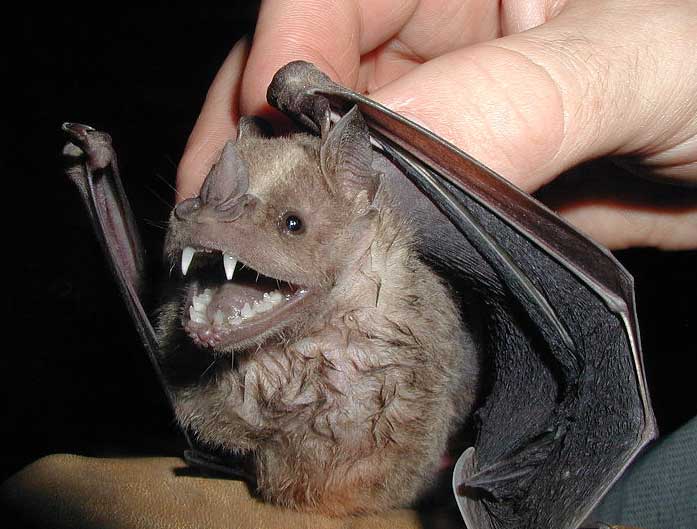
Ametrida centurio (*)
Superregnum: Eukaryota
Regnum: Animalia
Subregnum: Eumetazoa
Cladus: Bilateria
Cladus: Nephrozoa
Superphylum: Deuterostomia
Phylum: Chordata
Cladus: Craniata
Subphylum: Vertebrata
Infraphylum: Gnathostomata
Superclassis: Tetrapoda
Cladus: Reptiliomorpha
Cladus: Amniota
Cladus: Synapsida
Cladus: Eupelycosauria
Cladus: Sphenacodontia
Cladus: Sphenacodontoidea
OrdoTherapsida
Cladus: Theriodontia
Subordo: Cynodontia
Cladus: Mammaliaformes
Classis: Mammalia
Subclassis: Trechnotheria
Infraclassis: Zatheria
Supercohort: Theria
Cohort: Eutheria
Cohort: Placentalia
Cladus: Boreoeutheria
Superordo: Laurasiatheria
Ordo: Chiroptera
Subordo: Microchiroptera
Superfamilia: Noctilionoidea
Familia: Phyllostomidae
Subfamilia: Stenodermatinae
Tribus: Stenodermatini
Genus: Ametrida
Species: Ametrida centurio
Name
Ametrida centurio Gray, 1847
Type locality: Brazil, Para, Belem.
Synonyms
minor H. Allen, 1894
References
Gray, 1847. Proceedings of the Zoological Society of London, 1847: 15.
Conservation status: IUCN: Ametrida centurio (Least Concern)
Ametrida centurio in Mammal Species of the World.
Wilson, Don E. & Reeder, DeeAnn M. (Editors) 2005. Mammal Species of the World – A Taxonomic and Geographic Reference. Third edition. ISBN 0-8018-8221-4.
Distribution
Amazonian Brazil
Guianas
Panama
Venezuela
Trinidad
Bonaire Island (Netherlands Antilles)
Vernacular names
English: Little White-shouldered Bat.
The little white-shouldered bat (Ametrida centurio) is a species of bat from South and Central America. It is the only species within its genus, the name of which translates as "reaper" or "destroyer".[2]
Description
The little white-shouldered bat is a small phyllostomid bat, with males measuring 35 to 46 mm (1.4 to 1.8 in) and females 40 to 53 mm (1.6 to 2.1 in) in total length. The fur is generally brown, being paler underneath, and on the forequarters. As the common name suggests, both sexes have a spot of pure white fur on the shoulders near the base of the neck. The wings are also brown, and the uropatagium is hairy; the bats do not possess an external tail. The head has a relatively short, broad snout, with a wide mouth, and a simple, spear-like nose-leaf. The ears are small and triangular, and the eyes large and bulging, with a yellow iris.[2]
Distribution and habitat
Little white-shouldered bats are found throughout Venezuela, the Guyanas, on the island of Trinidad, and in eastern Colombia, north and central Brazil, and southern Panama. They have also been reported from Bonaire Island in the Netherlands Antilles.[1] Within this region, it is found in lowland evergreen and deciduous forest and swamps.[2] It is typically found below 1,500 m (4,900 ft), but some individuals have been caught as high as 2,100 m (6,900 ft).[1]
Biology
Little white-shouldered bats eat fruit, and forage from the forest floor to the canopy.[2] They have an unusually small brain, compared with their close relatives, and the cerebrum has virtually no sulci.[3] Little else is currently known of their biology, although pregnant females have been caught in July and August.[4] There are no recognised subspecies.[2]
References
Miller, B.; Reid, F.; Arroyo-Cabrales, J.; Cuarón, A.D. & de Grammont, P.C. (2008). "Ametrida centurio". IUCN Red List of Threatened Species. 2008. Retrieved 14 February 2009.
Lee, T.E. & Dominguez, D.J. (2000). "Ametrida centurio" (PDF). Mammalian Species. 640: 1–4. doi:10.1644/1545-1410(2000)640<0001:ac>2.0.co;2. Archived from the original (PDF) on 2015-09-24. Retrieved 2015-07-25.
McDaniel, V.R. (1976). "Brain Anatomy in Biology of bats of the New World family Phyllostomatidae" (PDF). Special Publications, the Museum, Texas Tech University Press. 10: 154–156.
Carter, C.H.; et al. (1981). "Observations on bats from Trinidad, with a checklist of species occurring on the island" (PDF). Occasional Papers, Museum of Texas Tech University. 72: 1–27.
Retrieved from "http://en.wikipedia.org/"
All text is available under the terms of the GNU Free Documentation License

